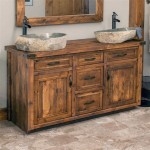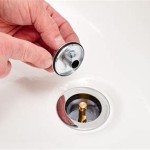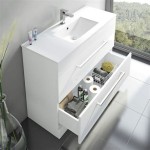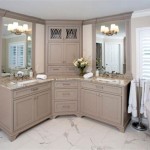Small Bathroom Vanities With Sink And Drawers: Optimizing Space and Storage
In compact living spaces, particularly within bathrooms, the selection of furniture requires a careful balance between functionality and spatial efficiency. Small bathroom vanities with sinks and drawers represent a practical solution for maximizing storage capacity while minimizing the footprint. These vanities are designed to integrate essential bathroom features—a sink and storage—into a single, streamlined unit, thereby optimizing the available room. This article explores the key considerations when selecting and integrating small bathroom vanities with sinks and drawers, emphasizing design principles, material choices, installation guidelines, and the impact on overall bathroom aesthetics.
Key Point 1: Design Considerations for Small Bathroom Vanities
The design of a small bathroom vanity with sink and drawers is paramount in determining its overall utility and appeal. Various design elements contribute to the functionality and aesthetic integration of the vanity into the bathroom space. These elements include the overall dimensions, configuration of drawers and cabinets, sink type, and style.
Dimensions and Space Planning: The dimensions of the vanity are critical to ensuring a comfortable and efficient layout. Small bathrooms often benefit from vanities ranging from 18 to 30 inches in width. The depth of the vanity is also a key factor. Shallower vanities, typically 16 to 18 inches deep, can provide more open space in front of the vanity. Before selecting a vanity, it is essential to measure the available space carefully and consider door swing, walking paths, and proximity to other fixtures.
Drawer and Cabinet Configuration: Drawer and cabinet configuration significantly impacts storage organization. Drawers are generally preferred for storing smaller items such as toiletries, makeup, and grooming tools, providing easy access and visibility. Cabinets, on the other hand, are better suited for larger items such as towels, cleaning supplies, and extra toilet paper rolls. The ideal configuration balances the number of drawers and cabinets to suit the specific storage needs of the user. Consider vanities with adjustable shelves within cabinets to accommodate items of varying sizes.
Sink Type and Placement: The type of sink integrated into the vanity also affects functionality and aesthetics. Common sink types include: Undermount sinks, offering a seamless transition from countertop to sink; vessel sinks, sitting atop the countertop as a focal point; integrated sinks, molded directly into the countertop; and drop-in sinks, fitting into a pre-cut hole in the countertop. Each sink type presents a unique aesthetic and influences the usable counter space. Placement of the sink, whether centered or offset, can also affect the available counter space and storage configuration.
Style and Aesthetic Integration: The style of the vanity should complement the overall aesthetic of the bathroom. Numerous styles are available, ranging from traditional to modern, minimalist to rustic. Choosing a style that aligns with the existing bathroom fixtures, tile, and color palette ensures a cohesive and visually pleasing design. Consideration should be given to the hardware (knobs and pulls) on the drawers and cabinets, as these details can significantly impact the overall style of the vanity.
Wall-Mounted vs. Floor-Mounted Vanities: A key design consideration is whether to opt for a wall-mounted (floating) or floor-mounted vanity. Wall-mounted vanities offer the advantage of creating a sense of spaciousness by exposing the floor beneath. This also simplifies cleaning. Floor-mounted vanities, conversely, provide more stability and may offer slightly more storage capacity, as they do not require wall reinforcement in some cases. The choice depends on personal preference, structural considerations, and the desired aesthetic.
Key Point 2: Material Choices and Durability
The materials used in constructing small bathroom vanities with sinks and drawers significantly influence their durability, aesthetics, and maintenance requirements. Selecting appropriate materials is crucial for ensuring the longevity and functionality of the vanity in the humid environment of a bathroom.
Cabinet Construction Materials: Common cabinet construction materials include solid wood, plywood, MDF (Medium-Density Fiberboard), and particleboard. Solid wood is often considered the most durable and aesthetically pleasing option, but it is also the most expensive. Plywood offers a good balance of strength and affordability, while MDF provides a smooth surface for painting or finishing. Particleboard is the least expensive option but is also the most susceptible to water damage. When selecting a vanity, it is important to consider the type of wood or wood composite used and the quality of the finish, which can significantly impact its resistance to moisture.
Countertop Materials: Countertop materials commonly used in small bathroom vanities include granite, quartz, marble, solid surface materials (such as Corian), laminate, and tile. Granite, quartz, and marble offer durability and aesthetic appeal but require regular sealing to prevent staining. Solid surface materials are non-porous and easy to maintain, making them a practical choice for bathrooms. Laminate is an affordable option that comes in a variety of colors and patterns, but it is less durable than other materials. Tile can add visual interest to a bathroom vanity but requires careful installation and grout maintenance to prevent water damage.
Sink Materials: Sink materials include porcelain, ceramic, cast iron, stainless steel, and glass. Porcelain and ceramic are the most common and affordable options, offering durability and ease of cleaning. Cast iron sinks with enamel coatings are durable and resistant to chipping but can be heavy. Stainless steel sinks are modern and easy to maintain but may be prone to scratching. Glass sinks add a unique aesthetic to a bathroom but require careful handling to prevent breakage.
Hardware Materials: The hardware (knobs, pulls, hinges, and drawer slides) should be made of durable materials such as stainless steel, brass, or zinc alloy. These materials are resistant to corrosion and can withstand frequent use. The quality of the hardware can significantly impact the overall functionality and longevity of the vanity.
Water Resistance and Sealing: Regardless of the materials chosen, it is crucial to ensure that the vanity is adequately sealed to prevent water damage. This includes sealing the seams between the countertop and the sink, as well as applying a waterproof sealant to any exposed wood or wood composite surfaces. Regular maintenance, such as wiping up spills promptly and addressing any signs of water damage, is essential for preserving the longevity of the vanity.
Key Point 3: Installation and Plumbing Considerations
Proper installation of a small bathroom vanity with sink and drawers is essential for ensuring its functionality, stability, and longevity. Installation involves both plumbing and carpentry skills, and it is often recommended to hire a professional plumber and/or carpenter for the job, especially if there are existing plumbing lines that need to be relocated or altered.
Pre-Installation Preparations: Before installing the vanity, it is important to shut off the water supply to the bathroom and disconnect the existing plumbing fixtures (sink, faucet, and drain). The area where the vanity will be installed should be clean and free of debris. Check the floor for levelness and make any necessary adjustments to ensure that the vanity will sit evenly.
Plumbing Connections: Plumbing connections involve attaching the water supply lines (hot and cold) to the faucet and connecting the drainpipe to the drain in the sink. Ensure that all connections are tight and leak-proof. Use Teflon tape on threaded connections to prevent leaks. If the existing plumbing lines do not align with the new vanity, they may need to be extended or relocated. This is a task best left to a professional plumber.
Vanity Mounting and Securing: Wall-mounted vanities require careful mounting to ensure that they are securely attached to the wall. This involves using appropriate wall anchors and screws that are capable of supporting the weight of the vanity and its contents. Locate the wall studs and attach the vanity to the studs whenever possible for maximum stability. Floor-mounted vanities should be leveled and shimmed if necessary to ensure that they sit evenly on the floor. Secure the vanity to the wall with screws or brackets to prevent it from tipping over.
Countertop and Sink Installation: If the countertop and sink are not pre-installed, they will need to be installed separately. Follow the manufacturer's instructions for installing the countertop and sink. Use a bead of silicone sealant around the edges of the sink to prevent water from seeping between the sink and the countertop. Secure the sink to the countertop using clips or brackets as instructed by the manufacturer.
Drawer and Hardware Installation: Install the drawers and hardware (knobs and pulls) according to the manufacturer's instructions. Ensure that the drawers slide smoothly and that the hardware is securely attached. Adjust the drawer slides if necessary to ensure proper alignment.
Post-Installation Checks: After installation, turn on the water supply and check for leaks. Inspect all plumbing connections, including the faucet, drain, and water supply lines. Run water in the sink to ensure that it drains properly. Check the drawers and doors to ensure that they open and close smoothly.
Compliance with Building Codes: Ensure that the installation complies with local building codes and plumbing regulations. This may involve obtaining permits and inspections. Consulting with a professional plumber or contractor can help ensure compliance and prevent potential problems in the future.
Selecting and installing a small bathroom vanity with sink and drawers necessitates a thorough understanding of design principles, material properties, and installation techniques. By carefully considering these factors, it is possible to create a functional and aesthetically pleasing bathroom space that maximizes storage and enhances overall user experience.

Magic Home 35 5 In Storage Bathroom Wood Vanity Cabinet With Ceramic Sink Combo Set White Sl Hwm3b31134ch The Depot

Three Posts Lauder 30 Single Bathroom Vanity Set Reviews Small Vanities

Diy Bathroom Vanity For 65 Angela Marie Made

18 Savvy Bathroom Vanity Storage Ideas

15 Small Bathroom Vanity Ideas That Rock Style And Storage

Glacier Bay Delridge Bath Suite With Two 24 In Vanities Vanity Tops And 2 Drawer Bases Pearl Gray Dr72p4v2 Pg The Home Depot

Diy Bathroom Vanity For 65 Angela Marie Made

15 Best Small Bathroom Vanities 2024 Our Favorite Finds

The Best 19 Small Bathroom Vanities Of 2024

Style Selections Morriston 24 In White Undermount Single Sink Bathroom Vanity With Engineered Stone Top The Vanities Tops Department At Com







